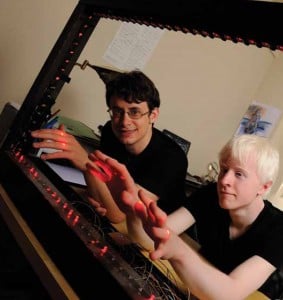Two undergrads create the miracle of music.
 This is no ordinary instrument: a tangle of colored wires spills out from the illuminated black wooden frame, onto a desk that also holds the laptop to which the entire contraption is attached.
This is no ordinary instrument: a tangle of colored wires spills out from the illuminated black wooden frame, onto a desk that also holds the laptop to which the entire contraption is attached.
The machine is silent, save for the laptop’s faint hum, until Stephen Edwards ’11 reaches forward and waves his hand inside the frame and the swirling sounds of a harp emerge- swelling and subsiding in tone and volume as his hand swipes up and down, back and forth, through the air.
It’s pretty cool. Or, as Edwards, who’s double majoring in computer engineering and music composition at Johns Hopkins’ Peabody Institute, describes it, “Awesome…because lasers plus music equals awesome.”
Edwards and Ryan Fay ’11, also a computer engineering major who has studied piano, music theory, and musicology at Peabody, designed and constructed the laser harp for their senior Electronic Design Lab. Says Edwards, “Our first goal, other than to get an A in the course, was to produce a serious instrument.” The duo received an A+.
Though other people have built laser harps, say the students, theirs is far more sophisticated than ones you might find on YouTube or at a science center. Most of these have just six to 12 strings and are limited in their usefulness as musical instruments.
Their harp is about 36 inches wide and 18 inches tall. Along the top interior edge, 32 glowing lasers are Krazy Glued in place, and another 16 are attached to the inside edge of one of the vertical boards. Across from each of the lasers, stuck to the frame’s opposite sides, are 48 small diodes. Eight toggle switches are lined up on the base.
According to Fay, their harp brings together all the aspects of what you would expect to find in a professional instrument. The 32 lasers across the top produce 32 notes, giving the instrument a range that spans from the lowest note you could play on a cello to about the highest. The vertical lasers control the volume. And then there are the toggle switches. Concert harps have seven pedals that can make every pitch sharp, flat, or natural. Fay explains that the toggle switches act as the harp’s pedals, providing full chromatic range, like playing the white and black keys on a piano. The eighth switch controls the harp’s all-chromatic and all-natural options.
Professor Ralph Etienne-Cummings says their project was a standout because “it captured the course’s entire chain of events”-from concept and planning through construction and budgeting, to a compelling demo. Edwards, who is now pursuing a concurrent BS/MS degree in computer engineering, plans to spend his master’s year building a new and improved laser harp. “You can’t define ‘prototype’ better than this,” Edwards says of the current instrument. Ultimately, Fay and Edwards’ goal is to create a product that’s marketable.
But they’re rightfully proud of what they’ve already made. “After the final 20 straight hours we spent in 123 Barton working on this, I can’t tell you how much of a miracle it felt like when we plugged it in and sound came out,” says Fay. “It was a labor of love.”




